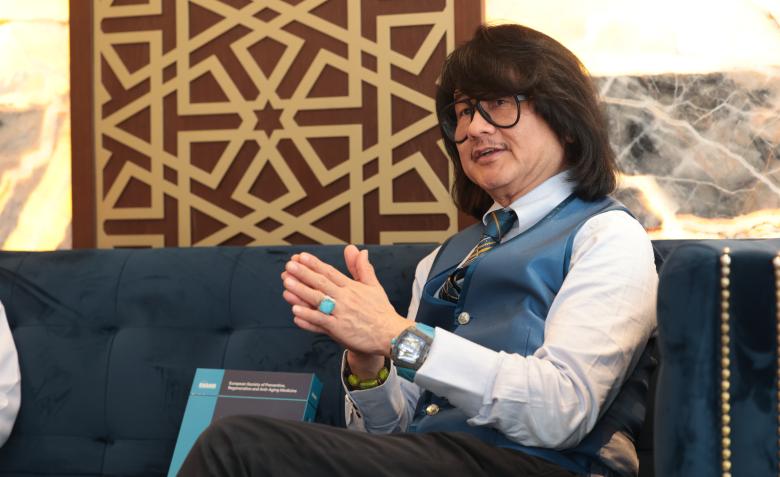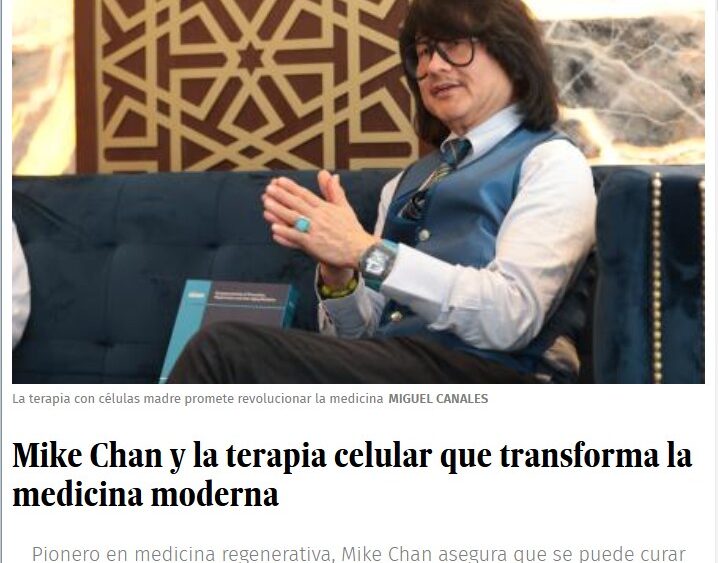By Miguel Canales
October 24, 2024
I find myself with Prof. Mike Chan in a spacious hall of a prestigious university. He is here for a seminar on cellular therapy and its applications in modern medicine. I’ve been informed that he is an internationally recognized authority on this topic, which has been challenging for me to research and understand.
A Multifunctional Space
I’m surprised to meet a doctor who is anything but conventional, just like the topic that brings him to our country. He wears white sneakers, a light blue jacket, and a tie with shiny gold and silver designs, and on his fingers, he sports two rings with large stones. Behind his glasses, his lively eyes peek through, as my grandmother used to say, and even though he just arrived from the United Arab Emirates, his energy is contagious.
His team includes an interpreter, tasked with ensuring that the terminology is accurate and clear, and a young Asian woman, like him, responsible for managing his numerous social media accounts. During our conversation, the doctor reminds me on several occasions of his chronological age (63 years) compared to his biological age (46 years). His secret is part of the method he comes to promote.
A Personalized Therapy
Currently, regenerative medicine is not yet part of the educational programs in many medical schools. But what is it exactly? Prof. Chan explains it very simply:
The term ‘bio’ refers to biological processes, and this branch of medicine seeks to treat the underlying causes of diseases, not just the symptoms.
This approach, developed by some countries over the years, focuses on identifying and addressing the root of the problem to achieve true healing.
Unlike traditional medications, regenerative medicine is based on stem cells, which are not considered conventional drugs, as they are living organisms that remain active in the laboratory for up to three days. While traditional drugs are produced in a standardized and homogeneous manner, this treatment is personalized according to each patient’s specific needs. For instance, every diabetic has a unique spectrum of symptoms and conditions, so the dosage should not be standard but adapted to the individuality of each person.
Are You Ready to Try a Cranial Massage?
Before initiating the procedure, a complete anatomical and pathological examination of the patient is conducted, regardless of whether they present a single disease or multiple conditions; the evaluation includes all organs and tissues in the body.
We focus on treating diseases considered untreatable, such as autoimmune diseases, including arthritis, multiple sclerosis, and autism. All of these conditions are treatable, as they relate to brain function. For example, autism can be approached as an attention issue,
he indicates.
After the evaluation, the necessary stem cells are injected intramuscularly, in an exclusive and personalized manner. This approach enables the regeneration of the damaged organ and even biological rejuvenation. He has treated patients as young as six months old, addressing problems from a holistic perspective, rather than viewing the patient as a collection of isolated symptoms. Prof. Chan asserts that there are no side effects associated with this therapy.
His Personal Struggle
Mike Chan has firsthand experience with the social challenges associated with a health condition, having been diagnosed with Asperger’s syndrome in childhood, a neurodevelopmental disorder that belongs to the autism spectrum (TEA). This issue is deeply personal for him, as he experienced the difficulties of autism firsthand. His childhood was particularly tough—he didn’t speak until he was 7 years old—and he was expelled from school multiple times due to his difficulty in socializing with other children.
His father, a man who worked at the Ministry of Education in Malaysia, took an interest in understanding what autism meant in the 1960s, when little was known about it. Despite the obstacles, Chan managed to overcome challenges. However, when he married, his second son, now 25 years old, was also diagnosed with a more severe form of autism. With effort and support, his son has successfully completed a degree in psychology.
Currently, some medical currents refer to the gut as a “second brain,” suggesting that various ailments originate there. However, the doctor notes:
It’s true that we need to address the problem from the gut and the accumulation of heavy metals in the body, which could cause certain diseases. However, the real challenge lies in the social aspects, related to the brain and emotions.
Advances and Challenges
Stem cells are present in all living organisms, from humans, the most intelligent animals, to plants. He acquired his technique in the 1980s, learning from Soviet pioneers in this methodology.
They used human fetuses, I cannot deny it. I am Buddhist, and my wife is Catholic, but I cannot hide the reality,
he comments. However, in Germany and Switzerland, where he runs his laboratory, sheep and cow fetuses are used.
If we extract stem cells from plants, we find they are not exactly the same, but in any other animal, the stem cells are identical.
All tissues and organs in the human body contain stem cells, playing a crucial role in their regeneration. However, their quantity decreases with age:
At 18 years, approximately 45% of the original stem cells are present; by 30, that figure drops to 25%; and by 60, only about 5% remain,
he comments.
The therapy, while promising, is not accessible to everyone due to its high cost, which can exceed $25,000. However, he hopes that in the future, these prices will decrease—with the support of state public health services—and become more affordable for a larger number of people.




Comments are closed.